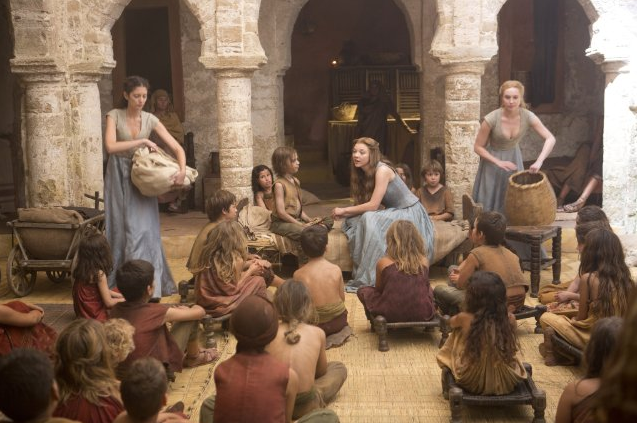A Brief Treatise on the Rules of Thrones 3.01: Valar Dohaeris
 |
| Smirking lessons |
State of Play
The choir goes off. There is a cold open running three minutes and set north of the Wall. The opening image is pitch black and inhuman screaming, then a fade-in on the windswept landscape and Sam running in terror.
The board is laid out thusly:
Lions of King’s Landing: Tyrion Lannister, Queen Cersei Lannister, The King’s Hand Tywin Lannister
Dragons of Astapor: Khaleesi Daenerys Targaryen
Direwolves of the Wall: Jon Snow
Direwolves of Harrenhal: The King in the North Robb Stark, Caetlynn Stark,
Bears of Astapor: Jorah Mormont
Mockingbirds of King’s Landing: Petyr Baelish
Ships of King’s Landing: Davos Seaworth,
Burning Hearts of Dragonstone: King Stannis Baratheon, Mellisandre
Roses of King’s Landing: Margery Tyrell
Archers of the Wall: Samwell Tarley
Stags of King’s Landing: King Joffrey Baratheon
Direwolves of King’s Landing: Sansa Stark
Tigers of Harrenhal: Talisa Stark
Flowers of King’s Landing: Shae
Bows of the Wall: Ygritte
Bears of the Wall: Lord Commander Jeor Mormont
Chains of King’s Landing: Bronn
Winterfell is abandoned and in ruins.
The episode is in eight parts. The first part runs seven minutes and is set at Mance Rayder’s camp north of the Wall. The transition is by location. The opening image is a snowy landscape, then Rattleshirt walking.
The second runs twelve minutes and is in sections; it is set in King’s Landing. The first section is seven minutes long; the transition is by hard cut, from Jon to children playing in the Blackwater, then into a brothel. The second section is five minutes long; the transition is by image, from the sky to the sky in a POV shot from a dazed Davos.
The third part run three minutes and is set at Harrenhal. The transition is by hard cut, from Davos and Sallador to the Stark banners.
The fourth runs nine minutes and is in two sections; it is set in King’s Landing. The first section is five minutes long; the transition is by implication; the letter Tywin is writing is early planning for the Red Wedding. The second section is four minutes long; the transition is by dialogue, from Tywin talking about Tyrion’s whores to Shae.
The fifth part runs two minutes and is set in Astapor. The transition is by image, from the water of Blackwater Bay to a dragon flying in the water.
The sixth runs three minutes and is set in Dragonstone. The transition is by image, once again to water.
The seventh runs six minutes and is set in King’s Landing. The transition is by hard cut, from Davos being dragged away to a street in Flea Bottom.
The eighth runs seven minutes and is set in Astapor. The transition is by dialogue, from Cersei and Margery talking about feeding the poor to Daenerys having the way the Unsullied have been starved explained to her. The final image is of Daenerys reacting to Barristan Selmy’s arrival by deciding to go for a Full Web.
Analysis
In the overall history of Thrones, this marks the start of a strangely transitional era. On the one hand it is part and parcel of the game’s imperial phase; on the other, a dead ball era or, if one prefers a teleological model, dumb period. When the show succeeds, and it often does, it is developing styles of play that will take it to some of its most fascinating heights. In other words, a problem period.
The most fundamental problem exists at the other end of the season, where a fundamentsl departure from the structure of the books leaves the show in unsettled waters. This is a crucial paradox, demonstrated by Ygritte at the outset as she accepts Jon Snow’s right to exit as a fundamental aspect of his freedom, but in turn asserts her own freedom to kill him. This, in turn, finds itself positioned in the maw of extinction, as Jeor Mormont expressly points out. And we have illustrated the lines between apocalypse and civilization: the free folk, the wall, and the small band of men crawling back to it with knowledge.
Obviously the most important figure within that structure is Jon Snow, what with secretly being a Targaryen and all, which is why we start with him after the basic scene setting. And the reason that’s important, as Mance Rayder bluntly points out, is that Jon Snow wants to be a hero. Indeed, his desire to be a hero is why he wants to be free, or at least, the story he tells Mance to convince him that he wants to be free, a story pinned on the horrors of Craster’s Keep and on Jon Snow’s desire to fight the White Walkers.
This is a fascinating decision, mostly for what it is not, which is in A Storm of Swords. The basic plot beat is there – indeed it’s Jon Snow’s first chapter, although Martin positions it after the introductions of Jaime, Catelyn, Arya, Tyrion, Davos, and Sansa. (Unsurprisingly, it’s Daenerys after Jon) But the method is entirely different; in the book Jon has Mance recount his own defection, and then responds consciously and methodically to that, selecting his anger at his bastardry as why he wants to be free because it will persuade Mance.
This in turn rests on a large edifice of omitted detail, including that Mance Rayder was actually at the feast for Robert’s arrival in Winterfell, one of the many bits of concise editing the series does to the books. For the most part it’s one that can validly and sensibly be seen as unfortunate. The loss of Jon’s interiority makes the account hollow. His bastardry is an oft-played card, it’s true, but it’s a sincere one, and its role in the story is to be sincere – to be a motivation that actually persuades Mance Rayder that Jon Snow, Ned Stark’s truest son, would betray his vows. The reference to Craster, on the other hand, is just a recap so that when Jeor pulls up in a few episodes we remember what it is. Similarly, the loss of Mance Rayder’s backstory makes the character entirely reliant on Ciarán Hines, who’s marvelous, but never gets to hit a note other than “he’s canny and charming.”
And yet it’s thematically much stronger; a point that emerges not from the by now tired adolescent psychology of Jon Snow but from the nature of Thrones as a game. A wave of civilizational annihilation sweeps in, and so heroes are necessary to prevent it. There is almost no clearer statement of ideology in the entire history of play.
Positioned immediately adjacent to it on the conceptual level is Tyrion, a second vision of The Hero (and indeed the hero of the previous season and credited Main Character henceforth) continuing his gradual traversal of the board, but at what is unquestionably a low point in his narrative. This is frustrating, and on a very basic level that will set the tone for the considerable problems that this season has. Simply put, there is no sense whatsoever in which Tyrion in his down and out state is as good television as Tyrion being Hand of the King is. I mean, it’s nice to see Bronn, and the Tyrion/Tywin scene is phenomenal, but there’s no way around the fact that Tyrion’s story is not as interesting right now as it was. And worse, that is for what feels like ultimately capricious and arbitrary reasons.
But Tyrion’s malaise is also symptomatic of the state of the world. This is an episode set among the ruins, whether the literal fringes of civilization, right on the edge of the Great Filter itself, the tatters of Stannis’s kingship, or simply the practical ruins of Harrenhal after the Mountain has ridden out. Tonally this is intriguing, and as a premiere it leads well to the triumphant return of Barristan Selmy, assuming you can remember who he is. And it is worth appreciating the relatively tight construction of this; eight parts, even if there are three hard cuts among them. This is, in other words, methodical and careful play. As it has to be; after two seasons in which the overall shape of play was relatively tightly dictated by the structures of A Game of Thrones and A Clash of Kings. Ultimately, those are the only two seasons to actually be based on books in normative senses; this and the next season are each based on half a book. The one after that is based on two books at once, and thereafter they’re not based on books at all, at least in any traditionally causal sense.
The title is thus, in the end, the most interesting part. All men must serve. On one level a simple call and response to the Season Two finale. On another, a commentary on the main theme. The Carlylean hero must be served; that is ultimately what his presence means. And this is presented as a fundamental fact of civilization; the alternative is extinction. And of course there is the obvious and most cloying observation; the one that notes that even the heroes like Jon and Tyrion must serve, and that the “all men” is in some sense honest. This can be called obvious; a nearly tautological confirmation that absolute power does not exist. But if Jon and Tyrion can be said to serve – that is, to have a master, the only master they could have is the history of which they are the heroes.
But what’s the difference between History and a White Walker?

January 12, 2016 @ 10:35 am
It is chronically unfair to drop a cliffhanger off the end of a literary essay.
January 12, 2016 @ 4:24 pm
Yeah, this isn’t Last War in Albion.
February 9, 2016 @ 2:35 pm
Really good to see the Brief Treatise back. Not too much to say at the moment as my memories of this section have faded a little. But yeah, the Tyrion at-bottom was not as gripping as watching him trying to subvert the Game.